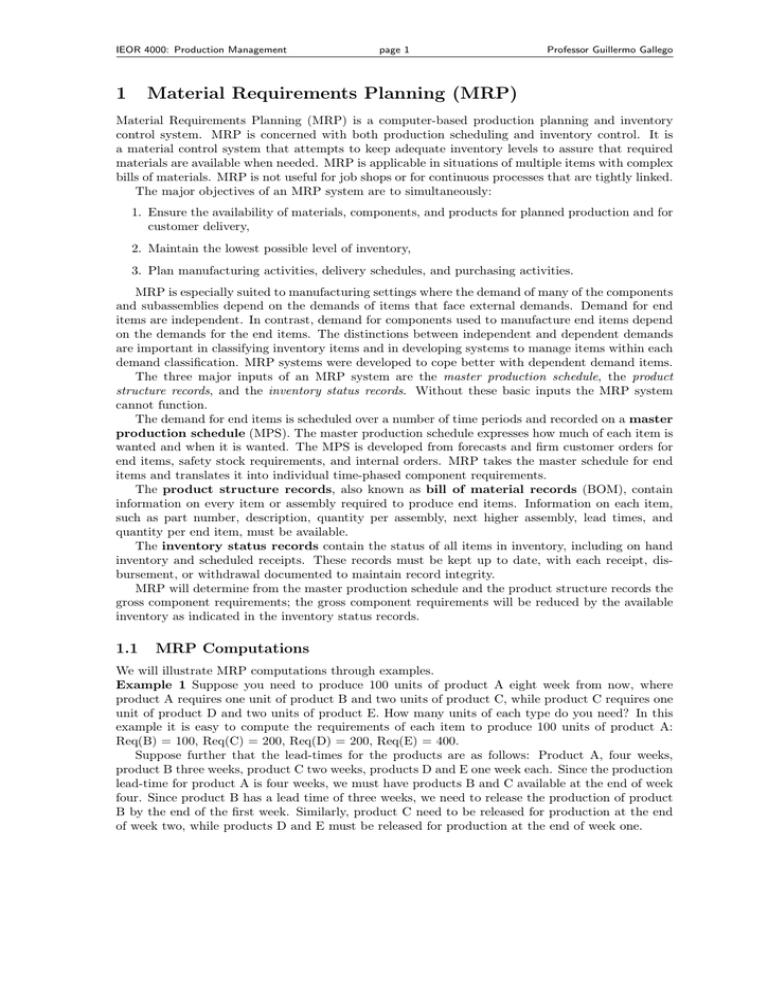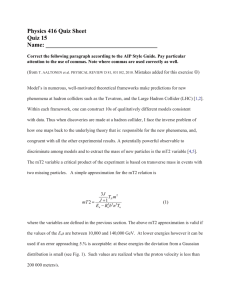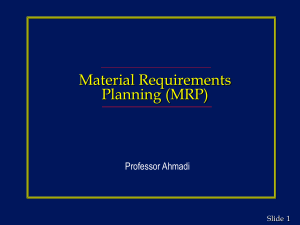1 Material Requirements Planning (MRP)
advertisement

IEOR 4000: Production Management 1 page 1 Professor Guillermo Gallego Material Requirements Planning (MRP) Material Requirements Planning (MRP) is a computer-based production planning and inventory control system. MRP is concerned with both production scheduling and inventory control. It is a material control system that attempts to keep adequate inventory levels to assure that required materials are available when needed. MRP is applicable in situations of multiple items with complex bills of materials. MRP is not useful for job shops or for continuous processes that are tightly linked. The major objectives of an MRP system are to simultaneously: 1. Ensure the availability of materials, components, and products for planned production and for customer delivery, 2. Maintain the lowest possible level of inventory, 3. Plan manufacturing activities, delivery schedules, and purchasing activities. MRP is especially suited to manufacturing settings where the demand of many of the components and subassemblies depend on the demands of items that face external demands. Demand for end items are independent. In contrast, demand for components used to manufacture end items depend on the demands for the end items. The distinctions between independent and dependent demands are important in classifying inventory items and in developing systems to manage items within each demand classification. MRP systems were developed to cope better with dependent demand items. The three major inputs of an MRP system are the master production schedule, the product structure records, and the inventory status records. Without these basic inputs the MRP system cannot function. The demand for end items is scheduled over a number of time periods and recorded on a master production schedule (MPS). The master production schedule expresses how much of each item is wanted and when it is wanted. The MPS is developed from forecasts and firm customer orders for end items, safety stock requirements, and internal orders. MRP takes the master schedule for end items and translates it into individual time-phased component requirements. The product structure records, also known as bill of material records (BOM), contain information on every item or assembly required to produce end items. Information on each item, such as part number, description, quantity per assembly, next higher assembly, lead times, and quantity per end item, must be available. The inventory status records contain the status of all items in inventory, including on hand inventory and scheduled receipts. These records must be kept up to date, with each receipt, disbursement, or withdrawal documented to maintain record integrity. MRP will determine from the master production schedule and the product structure records the gross component requirements; the gross component requirements will be reduced by the available inventory as indicated in the inventory status records. 1.1 MRP Computations We will illustrate MRP computations through examples. Example 1 Suppose you need to produce 100 units of product A eight week from now, where product A requires one unit of product B and two units of product C, while product C requires one unit of product D and two units of product E. How many units of each type do you need? In this example it is easy to compute the requirements of each item to produce 100 units of product A: Req(B) = 100, Req(C) = 200, Req(D) = 200, Req(E) = 400. Suppose further that the lead-times for the products are as follows: Product A, four weeks, product B three weeks, product C two weeks, products D and E one week each. Since the production lead-time for product A is four weeks, we must have products B and C available at the end of week four. Since product B has a lead time of three weeks, we need to release the production of product B by the end of the first week. Similarly, product C need to be released for production at the end of week two, while products D and E must be released for production at the end of week one. IEOR 4000: Production Management page 2 Professor Guillermo Gallego A material requirements plan has been developed for product A based on the product structure of A and the lead-time needed to obtain each component. Planned order releases of a parent item are used to determine gross requirements for its component items. Planned order release dates are simply obtained by offsetting the lead times. 2 The computations and steps required in the MRP process are not complicated. They involve only simple arithmetic. However, the bill-of-materials explosion must be done with care. What may get complicated is the product structure, particularly when a given component is used in different stages of the production of a finished item. 1.2 The Level of an Item To form a useful bill of material matrix it is convenient to order the items by levels. The level of an item is the maximum number of stages of assembly required to get the item into an end product. Example 2 Consider a system with two end items, item 1 and item 2. Item Item Item Item Item Item 1 requires two units of item A and one unit of item C. 2 requires one unit of item B, one unit of item D and three units of item E. A requires one unit of item B and two units of item F. B requires two units of item C and one unit of item E. C requires one unit of item F and three units of item G. D requires two units of item B and one unit of item C. The levels of the items are: Level Level Level Level Level 0: 1: 2: 3: 4: Items 1 and 2. Items A and D. Item B. Items C and E. Items F and G. 2 1.3 An Outline of the MRP Process Starting with end items the MRP process goes through the following steps 1. Establish gross requirements. 2. Determine net requirements by subtracting scheduled receipts and on hand inventory from the gross requirements 3. Time phase the net requirements. 4. Determined the planned order releases Week Gross requirements Scheduled receipts Net requirements Time-phased net req Planned order releases 1 2 3 Table 1: MRP Table 4 5 6 7 IEOR 4000: Production Management page 3 Professor Guillermo Gallego The planned order releases aggregated over all the end items will result in the gross requirements for level one items, the gross requirements for this items are then netted and time phased to determined their own order releases. The process is continued until all the items have been exploded. Table 1 shows a typical MRP table. Example 3 MRP computations are shown in Table 2 where the lead-time is two weeks. Here the planned releases were obtained by solving a Wagner-Whitin problem with time-varying demand. More often, however, MRP will plan releases in a lot-by-lot fashion. Week Gross requirements Schedule receipts Net requirements Time-phased net req Planned order releases 1 10 10 2 15 25 15 45 30 0 3 25 4 30 5 45 6 20 7 30 15 45 45 30 20 50 45 30 20 30 Table 2: Standard MRP Table 2 1.4 Computing Direct and Indirect Requirements Let Bij denote the number of units of item j required to make directly one unit of item i, and let Rij denote the total number of units of item j, direct or indirect, required to produce one unit of item i. Clearly Rii = 1, while for j 6= i we have X Rij = Bik Rkj k In matrix notation, we have R = I + BR so (I − B)R = I and R = (I − B)−1 . Let d be a row vector of item requirements, then dB and dR represent respectively, the direct and total derived demand. Example 4 We illustrate these concepts using the data from Example 2. 1 2 A 1 0 0 2 2 0 0 0 A 0 0 0 D 0 0 0 B= B 0 0 0 C 0 0 0 E 0 0 0 F 0 0 0 G 0 0 0 D 0 1 0 0 0 0 0 0 0 B 0 1 1 2 0 0 0 0 0 C 1 0 0 1 2 0 0 0 0 E 0 3 0 0 1 0 0 0 0 F 0 0 2 0 0 1 0 0 0 G 0 0 0 0 0 , 3 0 0 0 IEOR 4000: Production Management page 4 Professor Guillermo Gallego while 1 2 A 1 1 0 2 2 0 1 0 A 0 0 1 D 0 0 0 R= B 0 0 0 C 0 0 0 E 0 0 0 F 0 0 0 G 0 0 0 D 0 1 0 1 0 0 0 0 0 B 2 3 1 2 1 0 0 0 0 C 5 7 2 5 2 1 0 0 0 E 2 6 1 2 1 0 1 0 0 F 9 7 4 5 2 1 0 1 0 G 15 21 6 15 6 3 0 0 1 Thus, we need a total of 21 units of item G to manufacture one unit of item 2. Suppose that you require 120 units of product 1 and 100 units of product 2. What is the direct and total demand for the subassemblies? We can form a row vector d = ( 120 100 0 0 0 0 0 0 0), then dB = ( 0 0 240 100 100 120 300 0 0), and dR = ( 120 100 240 100 540 1300 840 1780 3900 ) . These formulas are very useful. To convince yourself try finding the total derived demand for G. See Excel file MRP.xls. 1.5 Expediting and Deferring Scheduled Receipts The process of determining net requirements, as outlined above, is to subtract scheduled receipts and on hand inventory from the gross requirements. Occasionally, because of anticipated changes in the MPS, we will find that the scheduled receipts are not enough to cover the gross requirements within a lead time. Consider, for example, Table 3, and assume that the lead time is three weeks. Notice that the schedule has a net requirement of 15 units in period 2. An order placed for 15 units in period 1 will arrive in period 4, so it would need to be expedited to be ready by period 2. An easier alternative, is to issue an expedite notice to the schedule receipt of period 3, stating that we need 15 units by period 2. Suppose that it is only possible to have 10 units ready by period 2. Then we will have a shortfall of five units. When a shortage occurs, it is important to backtrack and identify the source of demand. It may be that 10 of the 15 units required in period 2 are for actual orders, while the other five are in anticipation of future demand. In this case, we will allocate the 10 units to the actual order and avoid a stockout. On the other hand, there may be changes in the MPS that make scheduled receipts unnecessary. In that case the schedule receipts can be deferred to a later period. Week Gross requirements Schedule receipts Net requirements 1 10 10 2 15 15 3 25 25 4 30 5 45 6 20 7 30 30 45 20 30 Table 3: Expediting in MRP IEOR 4000: Production Management 1.6 page 5 Professor Guillermo Gallego Lot Sizing Rules The problem of lot sizing is one of satisfying the requirements while trying to minimize holding and setup costs. A variety of lot sizing rules have been proposed. The lot-for-lot (LFL) is the simplest approach, and it calls for producing in period t the net requirements for period t. The LFL approach minimizes the holding cost by producing just-in-time. This approach is optimal if setup costs and setup times have been reduced to negligible levels, but it may be expensive if setup costs are significant. A variety of lot sizing algorithms have been developed to deal with the case where setup costs are significant. The Wagner-Whitin (WW) algorithm can be used to optimally select the lot sizes at one level. However, applying the Wagner-Whitin algorithm, or any other single level approach, to different levels does not guarantee that the overall policy is optimal. An alternative to the Wagner-Whitin policy is the Silver-Meal (SM) heuristic. Starting from the first period with positive requirements, the SM heuristic attempts to cover more and more periods with one setup while the average cost of doing this is decreasing. Once it is determined that adding the requirements of the next period increases the average cost, a new setup is incurred and the method is repeated until all the requirements are covered. Another approach, which is popular in practice, is the part period balancing (PPB) heuristic which attempts to select the number of periods covered by a setup by making the holding cost over the covered horizon as close as possible to the setup cost. The fixed order quantity (FOQ) heuristic is to order a predetermined quantity whenever an order is placed. Finally, the fixed order period (FOP) heuristics calls for covering the demand of a fixed number of periods with one setup. Vollman et. al. [1] recommend the use of different lot-sizing rules for different levels in the BOM, with FOQ for end items, either FOQ or LFL for intermediate levels, and FOP for the lowest levels. The idea is to avoid the propagation of the bullwhip effect to the lowest items. 1.7 Dealing with Uncertainty in MRP There are several sources of uncertainty that we have ignored so far. These include uncertainty in the quantity demanded (forecast errors) and the quantity supplied (yield losses), and uncertainty in the timing of demand and the timing of supply (random lead times). Many MRP systems cope with uncertainty by inflating lead times (inducing safety time), by expediting orders, and by shifting priorities of shop and vendor orders. Another way of protecting against uncertainty is to carry safety stock for end items with random demand, and to carry safety stock of items produced at bottleneck operations. 1.8 1.8.1 Shortcomings of MRP Capacity MRP expects the lead time to be constant regardless of how much work has been released into the production system, so it is implicitly assuming infinite capacity. This can create problems when production levels are at or near capacity. One way to address this problem is to make sure that the MPS is capacity feasible. Rough-cut capacity planning (RCCP) attempts to do this by checking the capacity of a few critical resources. RCCP makes use of the bill of resources (BOR) for each item on the MPS. The BOR specifies the number of hours required at each critical resource to build a particular end item and its components, and then aggregates the number of hours required at each critical resource over the end items in the MPS. RCCP then checks whether the available resources are enough to cover the MPS on each time bucket. Notice that RCCP does not perform time offsets, so the calculation of the number of hours required has to be done with time buckets that are large enough so that parts and their components can all be completed within a single time bucket. This usually makes RCCP an optimistic estimation of what can be done. Advanced MRP systems provide more detailed capacity analysis proposing alternative production schedules when the current plan is not feasible. IEOR 4000: Production Management 1.8.2 page 6 Professor Guillermo Gallego Long Lead Times There are many pressures to increase planned lead times in an MRP system. MRP uses constant lead times when, in fact, actual lead times vary considerably. To compensate, planners typically choose pessimistic estimates. Long lead times lead to large work-in-process (WIP) inventories. 1.8.3 Nervousness MRP is typically applied in a rolling horizon basis. As customer orders firm up, and forecasts become better, a new MPS is fed to MRP which produces updated planned order releases that may be very different form the original. Even small changes in the MPS can result in large changes in planned order releases. Vollman et. al. [1], give an example where a small decrease in demand causes a formerly feasible MRP plan to become infeasible. 1.9 MRP II Manufacturing Resource Planning (MRP II) embeds additional procedures to address the shortcomings of MRP. In addition, MRP II attempts to be an integrated manufacturing system by bringing together other functional areas such as marketing and finance. The additional functions of MRP II include forecasting, demand management, rough-cut capacity planning (RCCP), and capacity requirement planning (CRP), scheduling dispatching rules, and input/output control. MRP II works within a hierarchy that divides planning into long-range planning, medium range planning, and short-term control. 1.10 ERP Systems and Bolt-Ons Enterprise resource planning (ERP) systems are extensions of MRP systems that run on a single database in a client server enviornment. ERP systems support marketing and finance departments in addition to the production department. Significant coordination advantages arise when all functions draw and add to the same data. SAP is currently the leading provider of ERP systems. Many companies such as i2 Technologies, and Manugistics have developed bolt-ons programs that run on top of ERP systems. These companies address specific problems that are not solved by ERP. For example, a better forecasting system or a finite-capacity scheduler can be added to SAP. Lately SAP has developed many of the capabilities that were formerly available only through bolt-ons. References [1] Volman, T, E, Berry, W.L., and Whybark, D.C. (1992) Manufacturing Planning and Control Systems, Third Edition, IRWIN, Burr Ridge, IL.




